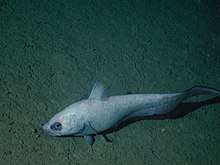Grenadiers (fish)
Grenadiers or rattails are generally large, brown to black gadiform marine fish of the subfamily Macrourinae,[1] the largest subfamily of the family Macrouridae. Found at great depths from the Arctic to Antarctic, members of this subfamily are amongst the most abundant of the deep-sea fish.[2]
| Grenadiers | |
|---|---|
 | |
| Coryphaenoides leptolepis | |
| Scientific classification | |
| Kingdom: | Animalia |
| Phylum: | Chordata |
| Class: | Actinopterygii |
| Order: | Gadiformes |
| Family: | Macrouridae |
| Subfamily: | Macrourinae Charles Lucien Bonaparte, 1831[1] |
The macrourins form a large and diverse family with 28 extant genera recognized (well over half of the total species are contained in just three genera, Coelorinchus, Coryphaenoides, and Nezumia). They range in length from about 10 cm (3.9 in) in Hymenogadus gracilis to 1.5 m (4.9 ft) in Albatrossia pectoralis. An important commercial fishery exists for the larger species, such as the giant grenadier and Coryphaenoides rupestris. The subfamily as a whole may represent up to 15% of the deep-sea fish population.
Typified by large heads with large mouths and eyes, grenadiers have slender bodies that taper greatly to very thin caudal peduncles or tails (excluding one species with no tail fin): this rat-like tail explains the common name 'rattail' and both the subfamily name and family name are derived from the Greek makros meaning "great" and oura meaning "tail". The first dorsal fin is small, high, and pointed (and may be spinous); the second dorsal fin runs along the rest of the back and merges with the tail and extensive anal fin. The scales are small.
As with many deep-living fish, the lateral line system in grenadiers is well-developed; it is further aided by numerous chemoreceptors located on the head and lips and chemosensory barbels underneath the chin. Benthic species have gas bladders with unique muscles attached to them. The animals are thought to use these muscles to "strum" their gas bladders and produce sound, possibly playing a role in courtship and mate location. Light-producing organs, photophores, are present in some species; they are located in the middle of the abdomen, just before the anus and underneath the skin.
Grenadiers have been recorded from depths of about 200 to 7,000 m (660–22,970 ft), and are among the most common benthic fish of the deep (however, two genera are known to prefer the midwater). They may be solitary or may form large schools, as with the roundnose grenadiers. The benthic species are attracted to structural oases, such as hydrothermal vents, cold seeps, and shipwrecks. They are thought to be generalists, feeding on smaller fish, pelagic crustaceans such as shrimp, amphipods, cumaceans, and less often cephalopods and lanternfish. As well as being important apex predators in the benthic habitat, some species are also notable as scavengers.
As few rattail larvae have been recovered, little is known of their life histories. They are known to produce a large number (over 100,000) of tiny (1–2 millimetres or 0.039–0.079 inches in diameter) eggs made buoyant by lipid droplets. The eggs are presumed to float up to the thermocline (the interface between warmer surface waters and cold, deeper waters) where they develop. The juveniles remain in shallower waters, gradually migrating to greater depths with age.
Spawning may or may not be tied to the seasons, depending on the species. At least one species, Coryphaenoides armatus, is thought to be semelparous; that is, the adults die after spawning. Nonsemelparous species may live to 56 years or more. The macrourins, in general, are thought to have low resilience; commercially exploited species may be overfished and this could soon lead to a collapse of their fisheries.
Genera
Currently 28 extant genera in this subfamily are recognized:[3]
- Albatrossia Jordan & Gilbert, 1898
- Asthenomacrurus Sazonov & Shcherbachev, 1982
- Cetonurichthys Sazonov & Shcherbachev, 1982
- Cetonurus Günther, 1887
- Coelorinchus Giorna, 1809
- Coryphaenoides Gunnerus, 1765
- Cynomacrurus Dollo, 1909
- Echinomacrurus Roule, 1916
- Haplomacrourus Trunov, 1980
- Hymenocephalus Giglioli, 1884
- Hymenogadus Gilbert & Hubbs, 1920
- Kumba Marshall, 1973
- Kuronezumia Iwamoto, 1974
- Lepidorhynchus Richardson, 1846
- Lucigadus Gilbert & Hubbs, 1920
- Macrosmia Merrett, Sazonov & Shcherbachev, 1983
- Macrourus Bloch, 1786
- Malacocephalus Günther, 1862
- Mataeocephalus Berg, 1898
- Mesovagus Nakayama & Endo, 2016 [4]
- Nezumia Jordan, 1904
- Odontomacrurus Norman, 1939
- Pseudocetonurus Sazonov & Shcherbachev, 1982
- Pseudonezumia Okamura, 1970
- Sphagemacrurus Fowler, 1925
- Spicomacrurus Okamura, 1970
- Trachonurus Günther, 1887
- Ventrifossa Gilbert & Hubbs, 1920
References
| Wikimedia Commons has media related to Macrourinae. |
- Nicolas Bailly, ed. (2015). "Macrourinae Bonaparte, 1831". WoRMS. World Register of Marine Species. Retrieved 1 April 2018.
- Froese, Rainer, and Daniel Pauly, eds. (2016). "Macrouridae" in FishBase. January 2016 version.
- Iwamoto, T., Nakayama, N., Shao, K.-T. & Ho, H.-C. (2015): Synopsis of the Grenadier Fishes (Gadiformes; Teleostei) of Taiwan. Proceedings of the California Academy of Sciences, 62 (3): 31-126.
- Nakayama, N. & Endo, H. (2016): Mesovagus, a replacement name for the grenadier genus Mesobius Hubbs and Iwamoto 1977 (Actinopterygii: Gadiformes: Macrouridae), a junior homonym of Mesobius Chamberlin 1951 (Chilopoda: Lithobiomorpha: Lithobiidae). Ichthyological Research, 64 (1): 120–122.